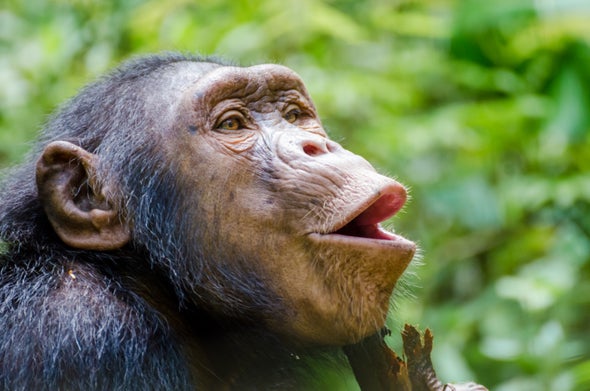(单词翻译:单击)
听力文本
This is Scientific American's 60-second Science, I'm Mark Stratton.
"Just imagine it, chatting to a chimp in chimpanzee."
Whether portrayed by Rex Harrison, Eddie Murphy or Robert Downey, Jr., Doctor Dolittle learned to talk to animals. But in reality, science has remained some distance from solving the long-standing question of how we humans learned to talk during our evolution.
Here's one new clue: a team of researchers in Great Britain have demonstrated how the rapid succession of opening- and closing-mouth rhythms by chimpanzees—known as "lip smacking"—mimics the natural pace of human mouths talking. The findings are in the journal Biology Letters.
This phenomenon has been observed before in other ape species who performed lip-smacking movements at around five hertz, which falls within a range of mouth opens and closes characteristic of all spoken languages, namely between two and seven hertz. But this lip-smacking timing connection had not been made in our closest evolutionary relatives—until now.
"Mouth and vocal signals with speechlike rhythms had already been observed in some monkeys, gibbons and orangutans, one of our closest great ape relatives. So the last years had seen accumulating evidence that these rhythms—other than something that talking humans do—that this was a rhythm from deeper within our primate ancestry, recycled, so to speak, as a cornerstone for speech evolution."

Adriano Lameira of the University of Warwick, who led the study.
"But the sense of evolutionary continuity toward speech still had a big gap to cross—the African apes. There was no evidence for speechlike rhythm, neither in gorillas, bonobos, nor chimpanzees."
The study followed two captive populations of chimpanzees, one in the U.K. and one in Germany, as well as two wild populations in Uganda. Researchers observed lip smacking at an average of 4.15 hertz. They made all their observations whenever a chimpanzee was grooming another. Think of a hairdresser engaging in idle chatter with a customer at the beauty salon.
"The confirmation of speechlike rhythm of the mouth in chimpanzees does not reveal, per se, how language came about in our own lineage. But it offers the final confirmation to scientists that we are looking at the right place, that we are on the right track to solve this mystery and that great apes in captivity and the wild still have to reveal all their secrets about human nature and human origins."
Lameira also notes that variation in lip-smack times both between and within the chimp groups do not appear to be hardwired. Rather the lip-smacking variability likely reflected how individual differences and environmental factors, and even social conventions, affect how chimpanzees communicate with each other. Even Doctor Dolittle might well be amazed.
Thanks for listening for Scientific American's 60-second Science. I'm Mark Stratton.
参考译文
这里是科学美国人——60秒科学系列,我是马克·斯特拉顿。
“想象一下,我们能和黑猩猩说猩猩语。”
无论由雷克斯·哈里森、艾迪·墨菲还是小罗伯特·唐尼扮演杜立德医生,这个角色都要学习与动物聊天。但现实中,科学离解决“人类在进化过程中如何学会说话”这个长期存在的问题还有一定距离。
这里有一个新线索:英国一个研究小组演示了黑猩猩快速连续开合嘴巴的节奏,即“咂嘴”,如何模仿人类嘴巴讲话的自然节奏。这项研究发表在《生物学快报》期刊上。
研究人员以前在其他类人猿身上也观察到过这种现象,猿类咂嘴动作的频率为5赫兹左右,处于所有口语的嘴巴开合特征频率范围(2-7赫兹)内。但这种定时咂嘴连接却未出现在我们最近的进化亲戚身上——直到现在还没有。
“在一些猴子、长臂猿和红毛猩猩(我们最近的类人猿亲属之一)身上,我们已经观察到了类似口语节奏的嘴部和声音信号。因此,最近几年我们看到有越来越多的证据表明,这些节奏与人类口语节奏不同,而是来自我们更久远的灵长类祖先,可以说,是作为语言进化的基石被循环使用。”
沃里克大学的阿德里亚诺·拉米拉领导了这项研究。
“但向口语发展的连续感仍有个巨大鸿沟要跨越——非洲猿。没有证据表明大猩猩、倭黑猩猩和黑猩猩身上出现过类似口语的节奏。”
这项研究追踪了两个被圈养的黑猩猩种群,一个种群在英国,另一个种群在德国,除此之外该研究还追踪了乌干达的两个野生种群。研究人员观察到咂嘴的平均频率为4.15赫兹。他们所有的观察都在黑猩猩互相梳毛时进行。想象一下,一名理发师在美发店和顾客闲聊。
“黑猩猩嘴部有类似口语的节奏,本身并未揭示语言在我们人类血系中是如何产生的。但这向科学家们提供了最终确认:我们的观察方向是对的,我们正在正确轨道上解决这一谜题,圈养和野生类人猿仍要揭示有关人性和人类起源的所有秘密。”
拉米拉还指出,黑猩猩群之间和群体内部的咂嘴节拍变化似乎都不是固定的。更确切地说,咂嘴可变性可能反映了个体差异、环境因素、甚至社会习俗对黑猩猩相互交流的影响。即使杜立德医生也会感到惊讶。
谢谢大家收听科学美国人——60秒科学。我是马克·斯特拉顿。
译文为可可英语翻译,未经授权请勿转载!
重点讲解
重点讲解:
1. in reality 事实上;实际上;
Outwardly she seemed confident but in reality she felt extremely nervous.
表面上看,她显得信心十足,而实际上她紧张得要命。
2. other than (用于否定陈述后)除了…以外;
I have no ambitions other than to have a happy life and be free.
我没有雄心大志,只求自由自在地过幸福生活。
3. so to speak 可以说;可谓;
The five countries have now all passed, so to speak, their entry test.
可以说,这5个国家现在都已经通过了入门考试。
4. per se 本身;本质上;
The drug is not harmful per se, but is dangerous when taken with alcohol.
这种药本身无害,但与酒同服就危险了。


